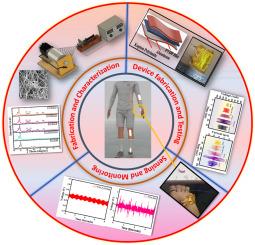Engineering of electrospun lead-free PVDF/Carbon Nanofiber-ZnO nanocomposites for enhanced piezoelectric energy harvesting and wearable sensing applications
IF 14.2
1区 材料科学
Q1 ENGINEERING, MULTIDISCIPLINARY
引用次数: 0
Abstract
Poly (vinylidene fluoride) (PVDF) is a promising lead-free piezoelectric polymer; however, its low β-phase fraction and limited charge transport hinder device performance. Here, we report a dual-filler strategy that synergistically integrates surface-functionalized carbon nanofibers (CNFs) and zinc oxide (ZnO) nanorods into electrospun PVDF fibers to simultaneously enhance β-phase nucleation, dipole alignment, and charge mobility. CNFs, at an optimized loading of 0.1 wt%, form conductive stress-transfer networks, while ZnO nanorods (1.5 wt%) with polar wurtzite facets act as efficient nucleating agents, promoting α→β phase transformation through localized electrostatic fields. Systematic variation of filler concentrations revealed that the 0.1 % CNF +1.5 % ZnO composition achieved the highest β-phase content (85.6 %) and piezoelectric coefficient (d33 = 36 pC/N), yielding an open-circuit voltage of 80 V and power density of 20 mW/cm3 under periodic tapping. The composite nanogenerator demonstrated stable, high-sensitivity performance in wearable sensing applications, including human joint motion monitoring. This work addresses the longstanding challenge of balancing mechanical flexibility with high piezoelectric activity in PVDF-based nanogenerators and establishes a scalable, lead-free approach for high-performance energy harvesting and self-powered sensing devices.

电纺无铅PVDF/碳纳米纤维- zno纳米复合材料增强压电能量收集和可穿戴传感应用的工程研究
聚偏氟乙烯(PVDF)是一种很有前途的无铅压电聚合物;然而,它的低β相分数和有限的电荷输运阻碍了器件的性能。在这里,我们报道了一种双填料策略,将表面功能化的碳纳米纤维(CNFs)和氧化锌(ZnO)纳米棒协同集成到静电纺PVDF纤维中,同时增强β相成核、偶极子排列和电荷迁移率。在0.1 wt%的优化负载下,CNFs形成了导电的应力传递网络,而具有极性纤锌矿面的ZnO纳米棒(1.5 wt%)作为有效的成核剂,通过局部静电场促进α→β相变。填料浓度的系统变化表明,0.1% CNF + 1.5% ZnO组合物的β相含量(85.6%)和压电系数(d33 = 36 pC/N)最高,在周期性分接下产生80 V的开路电压和20 mW/cm3的功率密度。复合纳米发电机在可穿戴传感应用中表现出稳定、高灵敏度的性能,包括人体关节运动监测。这项工作解决了在pvdf纳米发电机中平衡机械灵活性和高压电活性的长期挑战,并为高性能能量收集和自供电传感装置建立了一种可扩展的无铅方法。
本文章由计算机程序翻译,如有差异,请以英文原文为准。
求助全文
约1分钟内获得全文
求助全文
来源期刊

Composites Part B: Engineering
工程技术-材料科学:复合
CiteScore
24.40
自引率
11.50%
发文量
784
审稿时长
21 days
期刊介绍:
Composites Part B: Engineering is a journal that publishes impactful research of high quality on composite materials. This research is supported by fundamental mechanics and materials science and engineering approaches. The targeted research can cover a wide range of length scales, ranging from nano to micro and meso, and even to the full product and structure level. The journal specifically focuses on engineering applications that involve high performance composites. These applications can range from low volume and high cost to high volume and low cost composite development.
The main goal of the journal is to provide a platform for the prompt publication of original and high quality research. The emphasis is on design, development, modeling, validation, and manufacturing of engineering details and concepts. The journal welcomes both basic research papers and proposals for review articles. Authors are encouraged to address challenges across various application areas. These areas include, but are not limited to, aerospace, automotive, and other surface transportation. The journal also covers energy-related applications, with a focus on renewable energy. Other application areas include infrastructure, off-shore and maritime projects, health care technology, and recreational products.
 求助内容:
求助内容: 应助结果提醒方式:
应助结果提醒方式:


